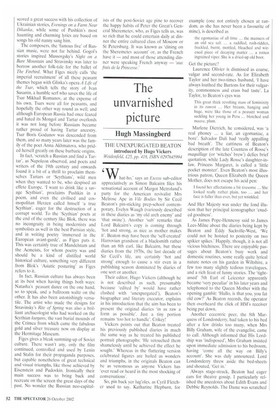Having things both ways
John Bayley
NATASHA'S DANCE by Orlando Figes
Penguin, £25, pp. 728, ISBN 0713995173
It all comes out of War and Peace? Well, Tolstoy makes a good starting-point anyway for such an adroit historian of place and people as Dr Figes. In an early chapter Natasha, the young Countess Rostov, is visiting 'Uncle', an old family friend and retired army officer who has gone native and lives in a wooden izba beside the forest
with his peasant mistress. Some visiting locals start to dance, and without thinking or knowing the complicated rustic measure Natasha joins in and executes the steps correctly, to general applause.
Well, well. However unaware of it she may be Natasha lives in two worlds, and finds herself as much at home dancing among the peasants as she has come to be in a Moscow ballroom. At least so Tolstoy says, and the idea clearly gives him great satisfaction. Figes omits to make the further point, heavily emphasised by Tolstoy himself, that Natasha must be taught the artificial culture of the West, exemplified by the ballet, which at first seems to be merely absurd and silly, while she instinctively responds to and joins in the peasants' dance.
Tolstoy in fact may be harking back to 1812, that annus mirabilis in Russian history. and the real centre of War and Peace, the great novel which he would never call a novel. For in 1812, as Figes demonstrates with a wealth of curious and delightful detail, the Russian upper class went Russian in a big way. A distant relative of Tolstoy's, whose sumptuous mansion on the English Embankment in St Petersburg was decorated in French Empire style, even went to the trouble and expense of having the bedrooms lined with rough wooden logs to give them the look of an izba. Russian folk tales became no less popular than log huts and peasant dances, and Gogol
scored a great success with his collection of Ukrainian stories, Evenings on a Farm Near Dikanka, while some of Pushkin's most haunting and charming lyrics are based on songs his old nanny sang him.
The composers. the 'famous five' of Russian music, were not far behind. Gogol's stories inspired Mussorgsky's Night on a Bare Mountain and Stravinsky was later to borrow another folk-tale for the ballet of The Firebird. What Figes nicely calls 'the imperial recruitment' of all these peasant themes began with Glinka's opera A Life of the Tsar, which tells the story of Ivan Susan in, a humble serf who saves the life of Tsar Mikhail Romanov, at the expense of his own. Tsars were all for peasants, and hopefully the other way round as well; and although European Russia had once feared and hated its Mongol and Tartar overlords it was not long before Russians became rather proud of having Tartar ancestry. Tsar Boris Godunov was descended from them, and so many years later was the family of the poet Anna Akhmatova, who prided herself greatly on these barbaric origins.
In fact, 'scratch a Russian and find a Tartar', as Napoleon observed, and poets and writers of the 19th century and onwards found it a bit of a thrill to proclaim themselves Tartars or `Scythians', wild men when they wanted to be, who despised an effete Europe. 'I want to drink like a savage Scythian', proclaims Pushkin in a poem, and even the civilised and cosmopolitan Herzen called hmself 'a true Scythian', eager for the destruction of a corrupt world. To the 'Scythian' poets at the end of the century like Blok, there was no incongruity in being modernists and symbolists as well in the best Parisian style, and in writing poetry 'immersed in the European avant-garde', as Figes puts it. This was certainly true of Mandelstam and the Acmeists, for whom poetry was and should be a kind of distilled world historical culture, something very different from Blok's 'Asiatic posturing' as Figes refers to it.
In fact, Russian culture has always been at its best when having things both ways: Natasha's peasant dance on the one hand, so to speak, and a ballroom waltz on the other. It has also been astonishingly versatile. The artist who made the designs for Stravinsky's Rite of Spring was also a brilliant archaeologist who had worked on the Scythian kurgans, the vast burial mounds of the Crimea from which came the fabulous gold and silver treasure now on display at the Hermitage Museum.
Figes gives a bleak summing-up of Soviet culture. There wasn't any, only the film continued, controlled and used by Lenin and Stalin for their propaganda purposes, but capable nonetheless of great technical and visual triumphs, like those achieved by Eisenstein and Pudovkin. Ironically their main success was to bring back and recreate on the screen the great days of the past. No wonder the Russian neo-capital
ists of the post-Soviet age pine to recover the happy habits of Peter the Great's General Sheremetev, who, as Figes tells us, was so rich that he could entertain daily at dinner the entire cultured class of Moscow or St Petersburg. It was known as 'dining on the Sheremetev account' or, as the French have it — and most of those attending dinner were speaking French anyway — 'aux frais de la Princesse.'



















































































 Previous page
Previous page